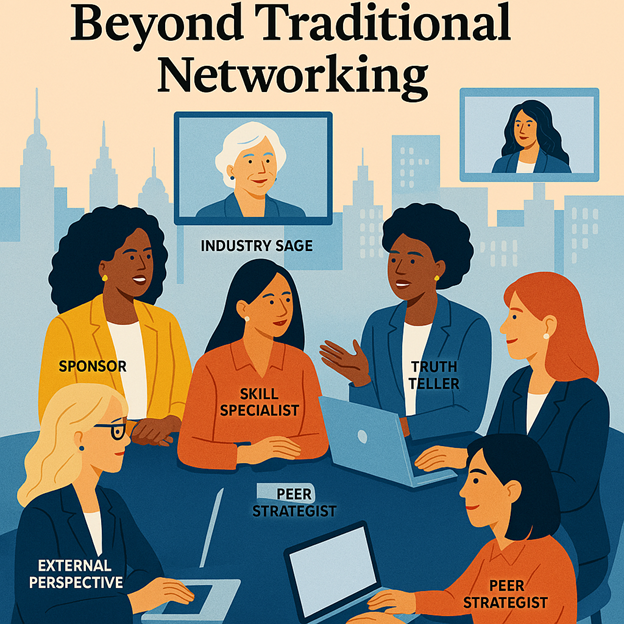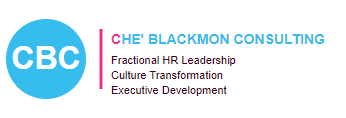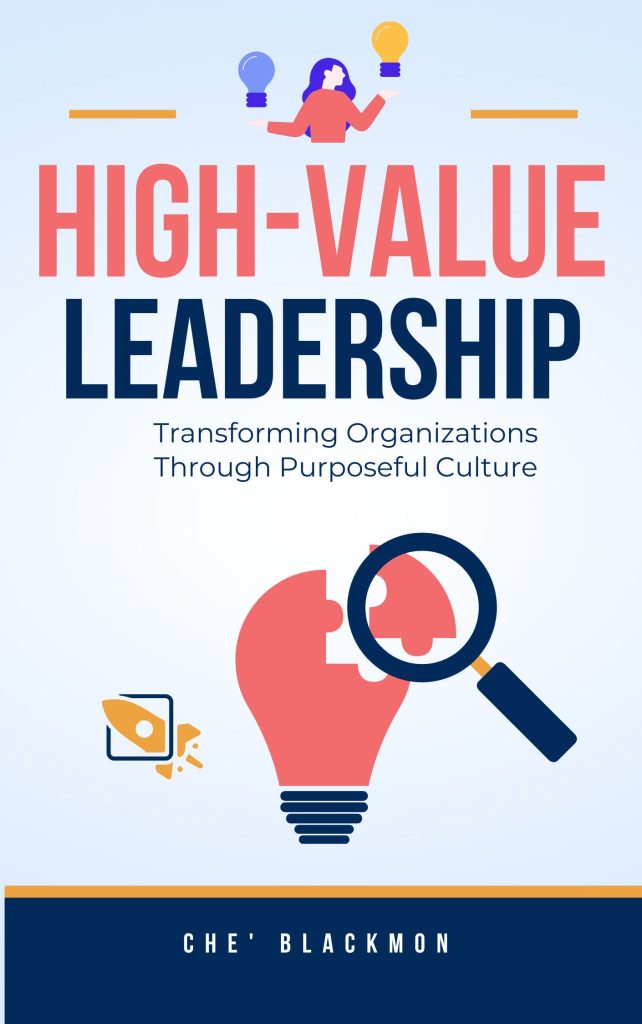Your cart is currently empty!
Networking events. Business card exchanges. LinkedIn connections. These traditional networking activities have their place, but if you’re serious about advancing your career—especially as traditionally overlooked talent—you need something more strategic: a personal board of directors.
Unlike casual networking that often leads nowhere, a personal board of directors is a carefully curated group of advisors who provide diverse perspectives, open doors, and hold you accountable to your highest potential. For Black women navigating corporate spaces where we’re often the “only one,” this strategic support system isn’t just helpful—it’s essential for breaking through systemic barriers.
Why Traditional Networking Falls Short for Traditionally Overlooked Talent 📊
Traditional networking operates on the premise of equal access and opportunity. Attend events, make connections, opportunities flow. But research from Harvard Business School shows that informal networks—where real opportunities circulate—are 71% homogeneous. When you’re not part of the dominant group, traditional networking often means being perpetually on the periphery.
There was a financial services firm where a talented Black woman attended every networking event, collected hundreds of business cards, and maintained an impressive LinkedIn presence. Yet after five years, she remained stuck in middle management while watching less qualified peers advance. The problem wasn’t her networking effort—it was her networking strategy.
She shifted from broad networking to building a strategic personal board of directors. Within 18 months, she secured a senior vice president role at a competitor. The difference? Quality over quantity, strategy over serendipity, and intentional relationship building over random connection collecting.
The Anatomy of an Effective Personal Board of Directors 🏛️
Your personal board should function like a corporate board—providing governance, guidance, and accountability for your career. But unlike corporate boards that often lack diversity, yours should be intentionally diverse in every dimension.
Essential Board Positions:
The Sponsor (Not Just a Mentor): Someone with organizational power who actively advocates for your advancement. They don’t just give advice—they put their political capital on the line for you. Research shows that Black women are over-mentored but under-sponsored, receiving plenty of guidance but limited advocacy.
The Industry Sage: A senior professional with deep industry knowledge who helps you see around corners and understand unwritten rules. They’ve navigated the terrain you’re entering and can share both the shortcuts and the landmines.
The Skill Specialist: Someone who excels in an area where you need development. This might be a financial expert if you’re moving toward C-suite roles, or a technology leader if you’re navigating digital transformation.
The Truth Teller: The person who gives you unvarnished feedback when everyone else is being polite. They care more about your growth than your comfort and will tell you what others won’t.
The Connector: Someone with extensive networks who opens doors you didn’t know existed. They’re the person who knows everyone and genuinely enjoys making strategic introductions.
The Peer Strategist: A colleague at your level who understands your current challenges and can share real-time intelligence. They’re navigating similar waters and can offer both tactical advice and emotional support.
The External Perspective: Someone outside your industry who brings fresh thinking and challenges your assumptions. They help you avoid industry tunnel vision and see innovative solutions.
As discussed in “High-Value Leadership,” diverse perspectives drive innovation and better decision-making. The same principle applies to your personal advisory board.
Strategic Selection: Quality Over Quantity 🎯
Building your board isn’t about collecting impressive names—it’s about strategic fit and mutual value exchange. Here’s what traditional networking guides won’t tell you: successful board building requires you to be selective and strategic, especially when you’re traditionally overlooked talent.
The VALUE Selection Criteria:
V – Vision Alignment: Do they understand and support your long-term vision? Board members who try to reshape you into their image rather than helping you achieve your vision aren’t true advisors—they’re projectors.
A – Access to Opportunities: Can they open doors that are currently closed to you? This doesn’t mean they have to be C-suite executives, but they should have influence in spaces where you need visibility.
L – Learning Potential: Will this relationship stretch your thinking and capabilities? The best board members challenge you to grow beyond your current limitations.
U – Unbiased Support: Will they advocate for you based on merit, not just when it’s convenient? For Black women, this means finding advisors who understand systemic barriers without using them as excuses for inaction.
E – Exchange of Value: What can you offer them? Contrary to popular belief, board relationships should be mutually beneficial, not one-way mentorship.
Beyond Coffee Chats: Structuring Board Engagement 💼
Random coffee chats don’t create strategic value. Your board needs structure to be effective.
There was a technology company where a Black woman product manager transformed her career by treating her personal board like an actual board. She held quarterly “board meetings” where she presented her progress, challenges, and strategic decisions. Her board members took it seriously because she took it seriously.
Structured Engagement Framework:
Quarterly Reviews: Schedule regular check-ins with your full board or individual members. Present your achievements, challenges, and strategic questions. This isn’t a casual chat—it’s a strategic session.
Annual Strategy Session: Once a year, gather your board (virtually or in person) for strategic planning. Review your trajectory, adjust your goals, and identify resources needed for the next level.
Issue-Specific Consultation: When facing major decisions or challenges, consult relevant board members. Don’t wait for scheduled meetings when you need strategic input.
Value Exchange Activities: Regularly provide value to your board members—share relevant articles, make strategic introductions, offer your expertise in their areas of need.
The Traditionally Overlooked Talent Advantage 🌟
Black women and other traditionally overlooked talent actually have unique advantages in building personal boards of directors—if we leverage them strategically.
Pattern Recognition: We’ve had to be hypervigilant about organizational dynamics, making us excellent at identifying who has real influence versus positional power.
Bridge Building: Our experience navigating different worlds makes us natural connectors who can build diverse, powerful boards that others might not envision.
Reciprocal Value: Our unique perspectives are increasingly recognized as valuable, especially as organizations prioritize diversity and inclusion.
Authenticity Assessment: We’ve developed strong instincts for identifying genuine allies versus performative supporters.
Research from McKinsey shows that diverse networks drive 35% better performance outcomes. As traditionally overlooked talent, we’re naturally positioned to build these diverse, high-performing networks—we just need to be strategic about it.

Current Trends: The Virtual Board Advantage 💻
The shift to remote work has democratized board building for traditionally overlooked talent. Geographic barriers that once limited access have dissolved, creating unprecedented opportunities.
Virtual Board Benefits:
- Access to global advisors without relocation
- Reduced time and financial barriers to engagement
- More scheduling flexibility for busy executives
- Ability to maintain boards across job changes
- Recording capabilities for reviewing strategic advice
There was a healthcare organization where a Black woman built her entire board virtually during the pandemic. Her board included leaders from Silicon Valley, New York, London, and Dubai. This geographic diversity provided perspectives that propelled her from director to C-suite in two years.
Digital Board-Building Platforms:
- LinkedIn for initial identification and connection
- Zoom/Teams for regular board meetings
- Slack/WhatsApp for ongoing communication
- Calendly for scheduling across time zones
- Notion/Airtable for tracking engagement and value exchange
Maintaining and Evolving Your Board 🔄
Your board isn’t static. As you grow, your board should evolve to meet new challenges and opportunities.
Board Lifecycle Management:
Addition Criteria: Add new members when entering new industries, taking on expanded responsibilities, or needing specific expertise. Each addition should fill a strategic gap.
Transition Protocols: Some board relationships naturally conclude when you’ve outgrown the need or the value exchange becomes imbalanced. Transition gracefully by expressing gratitude and maintaining the connection at a different level.
Succession Planning: As you advance, transition some advisors to emeritus status while they help identify their replacements. This maintains relationships while ensuring your board remains relevant.
Reciprocal Evolution: As you gain influence, become a board member for others. This creates a virtuous cycle of mutual advancement.
As explored in “Rise & Thrive,” Black women’s success is often interconnected. Building and serving on boards creates collective advancement, not just individual gain.
Common Pitfalls and How to Avoid Them ⚠️
Pitfall 1: The Gratitude Trap Being so grateful for attention that you accept any advisor without strategic evaluation. Solution: Remember that your time and potential are valuable. Be selective.
Pitfall 2: The One-Way Street Treating board relationships as purely extractive rather than mutually beneficial. Solution: Always consider what value you bring to the relationship.
Pitfall 3: The Homogeneous Board Building a board that looks and thinks like you, missing diverse perspectives. Solution: Intentionally seek advisors from different backgrounds, industries, and thinking styles.
Pitfall 4: The Passive Approach Waiting for advisors to guide you rather than actively managing the relationship. Solution: Take ownership of the relationship with structured engagement and clear asks.
Pitfall 5: The Stagnant Board Keeping the same advisors even when you’ve outgrown their guidance. Solution: Regularly evaluate and evolve your board composition.
Action Steps for Building Your Board 🚀
Week 1: Board Audit
- List current advisors and mentors
- Identify gaps in expertise, access, and perspective
- Define what you need for your next career phase
- Create your ideal board composition
Month 1: Strategic Outreach
- Identify 3-5 potential board members
- Craft personalized outreach messages
- Propose specific value exchanges
- Schedule initial conversations
Quarter 1: Board Formation
- Formalize relationships with clear expectations
- Establish meeting cadence and structure
- Create value exchange tracking system
- Hold first quarterly review
Year 1: Board Optimization
- Evaluate board effectiveness
- Add or transition members as needed
- Expand your reciprocal board service
- Document lessons learned and success metrics
Measuring Board Impact 📈
Track your board’s effectiveness through concrete metrics:
- Career advancement acceleration
- Salary/compensation improvements
- New opportunities accessed
- Skills developed
- Networks expanded
- Confidence increased
- Challenges navigated successfully
There was a consulting firm that studied employees with formal personal boards versus traditional networking approaches. Those with boards achieved promotions 40% faster and reported 60% higher career satisfaction.
Discussion Questions for Your Leadership Journey 🤔
- Who currently influences your career decisions, and are they strategically chosen or accidentally accumulated?
- What expertise or access do you need that your current network doesn’t provide?
- How might building a diverse board help you navigate systemic barriers more effectively?
- What unique value can you offer potential board members that creates mutual benefit?
- How would your career trajectory change with strategic advisors invested in your success?
Your Board-Building Opportunity
Building a personal board of directors isn’t about collecting business cards or LinkedIn connections. It’s about strategically assembling advisors who provide the guidance, access, and advocacy needed to navigate complex career landscapes—especially for those of us who face additional barriers.
Stop hoping traditional networking will suddenly work differently. Stop waiting for mentors to magically appear. Start building your strategic advisory board with the same intentionality you bring to your professional work.
Ready to build strategic career advancement systems?
Che’ Blackmon Consulting specializes in helping traditionally overlooked talent, particularly Black women, build powerful personal boards of directors and navigate corporate advancement strategically.
We’ll help you:
- Identify and approach strategic board members
- Structure board relationships for maximum impact
- Navigate complex corporate dynamics with advisor support
- Create mutual value exchanges that sustain relationships
- Leverage your board for breakthrough career advancement
Start building your strategic support system today:
📧 admin@cheblackmon.com
📞 888.369.7243
🌐 cheblackmon.com
Because exceptional careers aren’t built alone—they’re built with strategic support. #PersonalBoard #CareerStrategy #NetworkingStrategy #BlackWomenLead #LeadershipDevelopment #CareerAdvancement #ProfessionalGrowth #WomenInLeadership #StrategicNetworking #ExecutivePresence #CareerSuccess #DiversityInLeadership #Mentorship #Sponsorship #HighValueLeadership


